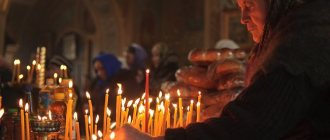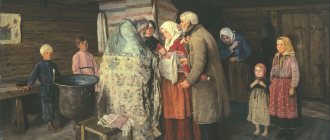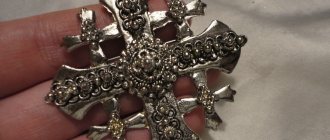Audio version of the article
- About scarves and hats... priest. Konstantin Parkhomenko
***
Head covering is a religiously motivated practice of covering the head with a headdress, originating in the Old Testament, which had (and has) many regional and local differences throughout the history of Christianity.
Where did the custom come from?
In the time of the Apostle Paul, young unmarried girls could go bareheaded. They wore their hair long; cutting it was a shame; it was a symbol of virtue. They were cut and shaved by harlots. Married women with loose hair were considered libertine; once married, they could not appear in public with their heads uncovered. Only the husband could look at the hair.
The Apostle Paul, in the section of the sacred text “Message to the inhabitants of the city of Corinth” (verse 1-16, chapter 11), on the one hand, reflected the mores of his time, and from the point of view of Christianity, explained why women should cover their heads when entering the temple.
The apostle wanted people to behave accordingly when standing before the cross in the temple, remembering the sacrifice of God. At the ecclesia, a man praying or prophesying must show the image of Christ, with his head uncovered. A woman represents the image of the Church, covering her head during prayer, demonstrating obedience to the Word of God, and at the same time covering her sins.
Is head covering a cultural expression?
Questions about covering a woman's head are certainly not a theological issue. This is not a question about who God is, and not about the basic tenets of Christianity! This may be some kind of doctrinal issue, but definitely not theological!
You may have read somewhere my statements that covering a woman’s head during prayer should be interpreted as a cultural manifestation. I still adhere to this point of view. You ask how we can be sure of this, and that it is not a mandatory commandment to fulfill? My answer is that we cannot be absolutely sure of this. This may be a controversial issue, although I'm pretty sure I'm right. I would say that if it is THAT important, God would have made it clearer and more visible somehow. I think you probably need to just relax about it. The idea that anyone's salvation depends on this thing is truly unreasonable. The very idea that our salvation depends on what we wear tells me that a person who thinks in this way is completely confused about his understanding of God.
Church opinion
The Bible texts regarding the culture of behavior and clothing within the walls of the temple should be interpreted according to the time and traditions of a particular country. Believers must wear clothing in church that does not discredit the Christian faith.
There is no detailed teaching on the need for headdress in the temple. Ministers of different Orthodox churches interpret in their own way the texts of the Holy Scriptures, written in an ancient language. The words “shame” and “glory” that the Apostle Paul uses in his verses have their own cultural characteristics in different countries.
In Greece, Orthodox believers of any gender visit churches and pray to the Lord without covering their heads. This tradition appeared during the Turkish invasion of the country. Muslims forced the female population of the country to wear a hijab in all public places - a veil that covers the head and most of the figure.
Greeks who converted to Christianity protested against forced Islamization. Temples were visited at night. Upon entry, hats were removed as a matter of principle. This tradition is over 200 years old. Modern Greek women do not cover their heads in churches; church ministers do not recognize this as a violation of religious rules.
Orthodox Russia has developed its own historical traditions. Starting from the 15th century, their formation was influenced by the Domostroy collection. It contained instructions concerning rules, mainly religious and family. According to Domostroy, a woman’s head covered with a scarf symbolizes humility, modesty, and the wife’s subordination to her husband. According to the traditions of those times, both married and unmarried women were required to cover their heads with a scarf when entering the church.
Modern women have equal rights with men in society and family. The headscarf, as a symbol of submission, has lost its relevance. Church ministers do not insist on head covering. The believers themselves preserve ancient Christian traditions, monitor their implementation, and instill them in their children. Even little girls are tied with a headscarf when entering the temple.
Green - Trinity
Green color is associated with the holiday of Trinity and Spiritual Day. These days, churches are decorated with young birch trees and grass, and there is a tart smell of greenery. Believers bring birch branches for consecration, priests are dressed in green vestments.
Trinity or Pentecost is the birthday of the modern Church. In the Old Testament, it was an agricultural holiday; thanksgiving was offered to God for the first harvest. After the Resurrection of Christ, the holiday of the Trinity took on a different meaning. On this day there was a descent of the Spirit of God on the Apostles. And the disciples of Christ spoke in different languages, and the people who witnessed this miracle were amazed at what was happening. Some accused the Apostles of drinking too much wine, hence the strangeness of their speech. But witnesses came to their defense, talking about what happened. The gospel must be preached throughout the world, in all languages - and so the prophecy was fulfilled.
The Apostle Paul preached a sermon that day, after which more than 3 thousand people were baptized. Thus was born the New Testament Church.
Green color is obtained by mixing blue and yellow. The Lord came to earth to open the way to the Kingdom of Heaven for humanity. With the help of Communion, a person is united with Christ, ascending to heaven (in a figurative sense).
That is why Orthodox Christian women tie a green scarf on these holidays.
Shawl for church PTK180012
1 200 ₽
The church scarf is made of delicate powder-mint chiffon, edged with lace in the color of the main fabric.
Temple scarf PTK180018
1 100 ₽
The temple scarf is made of delicate chiffon in a powdery mint color, edged with satin bias tape in the color of the main fabric.
Scarf snood for the temple SND180022
1 300 ₽
Temple scarf made of chiffon in a powdery-mint color, trimmed with delicate lace along the edge.
Temple scarf PTK190034
1 800 ₽
The temple scarf is made of rich green lace fabric. The edge is edged with lace in the color of the main fabric.
Temple scarf PTK190053
800 ₽
Temple scarf made of sparse chiffon in a powdery mint color. The edge is edged with satin bias tape, and the front part is trimmed with guipure lace.
Recommendations for choosing a headdress
The color scheme is a mandatory attribute of Orthodox symbolism and reflects the spiritual essence of the service. The color of priests' vestments strictly corresponds to church canons. True believers have holiday scarves of different shades. There are rules when to wear them.
| Color of headdress (scarf, headscarf) | Rituals, services | Church holidays |
| White is a symbol of joy | Wedding | Epiphany |
| Baptism | Presentation of the Lord | |
| Burial rite | Ascension of the Lord | |
| Red is a symbol of the blood of Christ | About the martyrs | Easter (40 holidays) |
| Maroon | – | During Holy Week (Maundy Thursday) |
| Shades of yellow and orange are a symbol of triumph and dignity | On Sundays, but not holidays | At a service in honor of Jesus Christ, apostles, prophets, equal to the apostles, saints |
| Green is a symbol of life-giving | – | Palm Sunday, Trinity, days of remembrance of saints, Holy Spirit Monday |
| Blue and light blue - purity | Days when the icon of the Blessed Virgin Mary is venerated | Dormition, Intercession, Annunciation |
| Purple - the suffering of Christ | Sunday services held during Lent and the Week of the Cross | Exaltation |
| Black, dark blue and brown | Great Lent and Holy Week - weekdays, days of mourning | Liturgy of the Presanctified Gifts |
You can cover your head with floral scarves. This type of cover is the most common. The church does not require you to strictly comply with the requirements listed in the table; you can follow simple rules:
- do not enter the temple wearing a scarf with incomprehensible symbols;
- on days of fasting and mourning, cover your head with scarves of dark shades;
- Do not come to the funeral service wearing brightly colored scarves.
The choice of color and design of a scarf is a personal matter for the believer, a reflection of her true love for the Lord, her Christian humility.
How to tie a scarf correctly
Hair has always been considered a symbol of female beauty and has attracted attention. At any time, it was not customary to wear voluminous hair when visiting a temple. Extravagant persons who violated this requirement were simply not allowed into the church. This tradition has been preserved. Hair is neatly styled. A scarf is tied on the head or worn:
- snood - a hood-shaped headdress covering the head and shoulders, made of silk chiffon;
- stole - a large scarf that covers the head and shoulders.
Parishioners wear church scarves in a special way. Fancy shaped bows and complex shaped knots are excluded. You can wear a headdress according to the old Orthodox custom - cover your forehead with a scarf, and fasten the edges under the chin with a pin.
Young girls and women can throw a light scarf over their heads, throw the ends behind their backs and tie them there around the neck with a loose knot. Silk scarves are not tied; one or both ends are thrown over the shoulders or secured with modest hairpins. Shawls, stoles, scarves should not fall off the head during prayer, distracting the believer and other parishioners from prayer and communication with the Lord.
Can tradition become obsolete?
For example, why worship is held this way and not otherwise. Or why exactly these attributes are used, and not some others. Therefore, the first and most correct answer as to why one cannot go without a headscarf is because this is the tradition of the Orthodox Church. And those who accept this faith must follow its dogmas and traditions unquestioningly and not question them.
The opinion about the outdated tradition began from the moment when some clergy, in the process of increased secularization of the church and attempts to attract as many parishioners as possible, started talking about it.
Some people think that since no one wears headscarves now, girls and women can come with their heads uncovered. This is motivated by the fact that it is better to visit a temple without a headscarf than not to go there at all.
In some monasteries, upon entering, visitors are given a variety of hats, including a lace scarf and snood.
Sometimes, to enter the territory of a temple or monastery, it is enough to throw a hood over your head.
How much this corresponds to Orthodox traditions is difficult to understand. The rules of church worship oblige a woman to enter the temple with her head covered. It doesn’t seem to matter what exactly she puts on her hair, the main thing is that it is covered.
The secularization of religion in attempts to attract parishioners has led to the fact that fasting is considered permissible in a relaxed form, the main thing being attending church.
The same is the case with the strict rules of some major holidays, during which the church allowed conditional actions to be performed. Although there are predeterminations that until recently it was customary to follow.
The indignation of those who address the obsolescence of headscarves, while covering their heads in church with various substitutes, is incomprehensible. Some people use a neck stole, while others use a lace scarf through which the hair is completely visible.










